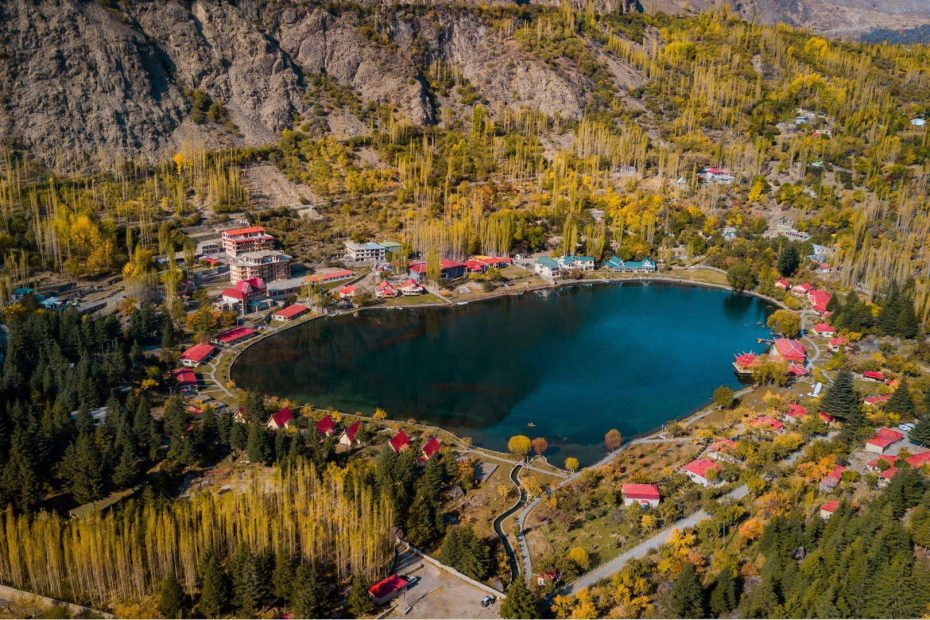Imagine exploring a land where ancient history meets breathtaking landscapes and diverse cultures. Pakistan, often overlooked by travelers, offers a rich world of experiences waiting to be discovered. Whether you’re trekking through the majestic Karakoram Range or wandering the bustling streets of Lahore, this vibrant country promises adventure at every turn.
In this comprehensive 4-week itinerary, you’ll uncover the hidden gems and iconic landmarks that make Pakistan a traveler’s paradise. From the serene valleys of Hunza to the historic ruins of Mohenjo-Daro, each day will bring new sights and stories. Ready to begin on a journey that will leave you spellbound? Let’s jump into the ultimate Pakistani adventure.
Key Takeaways
- Pakistan offers a rich blend of ancient history, breathtaking landscapes, and diverse cultures, making it a rewarding travel destination.
- The best time to visit varies by region; northern areas are ideal in summer and autumn, while southern regions are more comfortable in winter.
- Must-see attractions include the serene valleys of Hunza, the historic ruins of Mohenjo-Daro, and cities like Lahore and Islamabad with their key landmarks.
- Transportation within Pakistan can be optimized using domestic flights for long distances, and shared taxis or hired cars for more flexible and scenic routes.
- Accommodations range from luxury hotels to budget-friendly guesthouses, offering various amenities and price points to fit different travel styles.
- Sustainable travel practices such as minimizing plastic use and respecting local cultures enhance the travel experience while preserving the natural environment.

When to Visit Pakistan
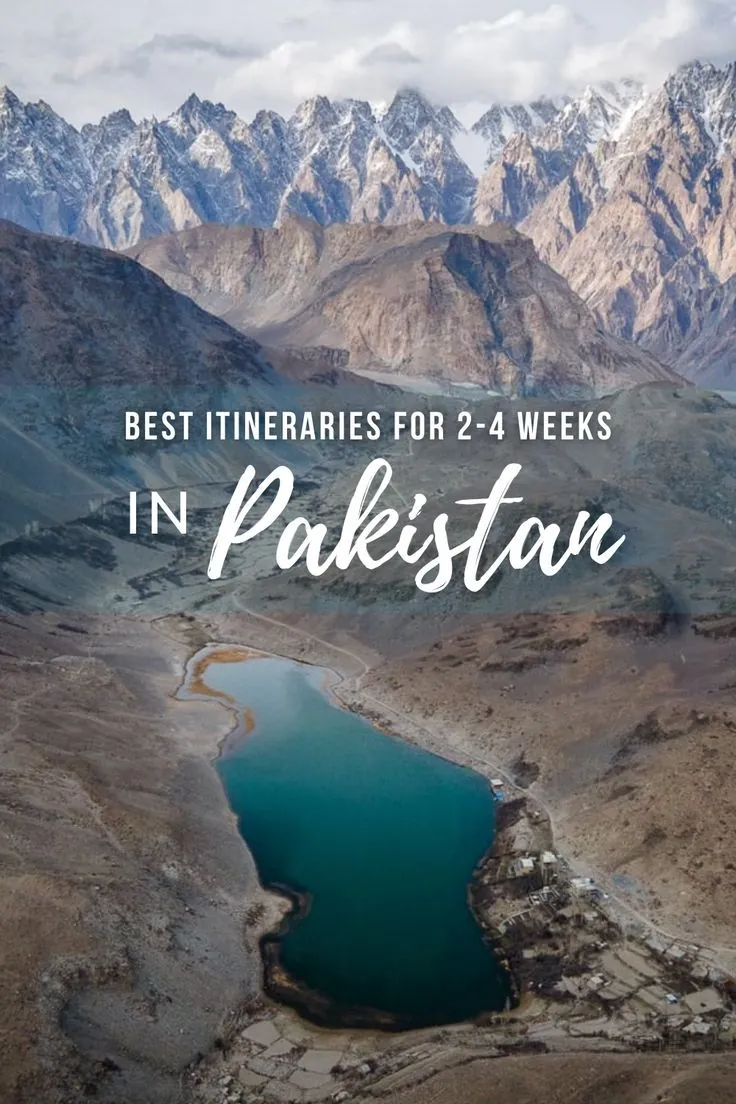
When planning a trip to Pakistan, consider your ideal weather conditions to make the most of your visit. Pakistan offers diverse climates, landscapes, and activities throughout the year.
Climate Overview
Pakistan’s climate varies significantly across its regions. The northern areas, including Gilgit-Baltistan, experience cold winters and pleasant summers. The southern regions, like Sindh and Balochistan, have mild winters and hot summers.
| Region | Season | Temperature Range (°F) | Highlights |
|---|---|---|---|
| Northern Areas | Summer | 50-77 | Ideal for trekking and sightseeing |
| Northern Areas | Winter | 15-30 | Snow activities, fewer tourists |
| Southern Regions | Summer | 77-104 | Coastal activities, historical sites |
| Southern Regions | Winter | 50-77 | Comfortable weather for exploring |
Best Time To Visit
Pakistan’s tourist attractions vary by season. Most travelers prefer visiting in spring (March to May) and autumn (September to November) due to moderate temperatures and clear skies.
In spring, the northern areas come alive with blossoms, making it perfect for exploring the Hunza Valley, Gilgit, and Skardu. Autumn, on the other hand, offers breathtaking views of colorful foliage, especially in the valleys of Gilgit-Baltistan.
Monsoon season (July to August) brings heavy rains to the north but offers a cooler climate in the south, ideal for exploring Karachi and the coastal areas.
Top Attractions By Season
- Spring: Hunza Valley, Gilgit, Skardu
- Summer: Naran, Kaghan Valley, Phander Lake
- Autumn: Gilgit-Baltistan, Shandur Pass, Fairy Meadows
- Winter: Murree, Malam Jabba, Swat Valley
Hidden Gems
Experience off-the-beaten-path destinations during your visit. In spring, visit Ghulkin Village in Hunza for its serene environment and warm hospitality. Summer is perfect for discovering the remote beauty of Phander Lake. For autumn, venture to the scenic Ghizar Valley. In winter, explore the quaint town of Kalam in Swat Valley.
Accommodations
Choose your accommodations based on comfort, budget, and location. Here’s a comparison of popular options:
| Accommodation | Location | Price Range (USD) | Amenities |
|---|---|---|---|
| Serena Hotel | Islamabad | 150-300 | Luxury rooms, pool, spa |
| Lake Inn Phander | Phander | 50-100 | Scenic views, cozy lodging |
| Eagle’s Nest | Hunza | 100-200 | Panoramic valley views, dining |
| Hilltop Hotel | Skardu | 75-150 | Traditional rooms, mountain views |
Dining Highlights
Delight your taste buds with Pakistan’s diverse cuisine, known for its rich flavors and spices. In northern areas, try the local delicacy, chapshuro. In Islamabad, savor mouth-watering nihari and kebabs. Karachi offers delectable seafood, and Lahore is famous for its street food, like golgappa and chana chaat.
Transportation & Practical Tips
Exploring Pakistan is a blend of modern convenience and rugged adventure.
- Domestic Flights: Quickest way to cover long distances, especially between northern and southern regions.
- Buses & Coaches: Cost-effective and ideal for longer journeys; services like Daewoo offer comfort.
- Trains: Scenic routes connecting major cities; opt for AC classes for comfort.
- Hiring a Car: Offers flexibility; hire a local driver for convenience and safety.
Safety Tip: Always check the latest travel advisories and stay updated on local news.
Sustainability Tip: Respect local cultures and traditions, minimize plastic use, and support eco-friendly accommodations.
Getting Around Pakistan
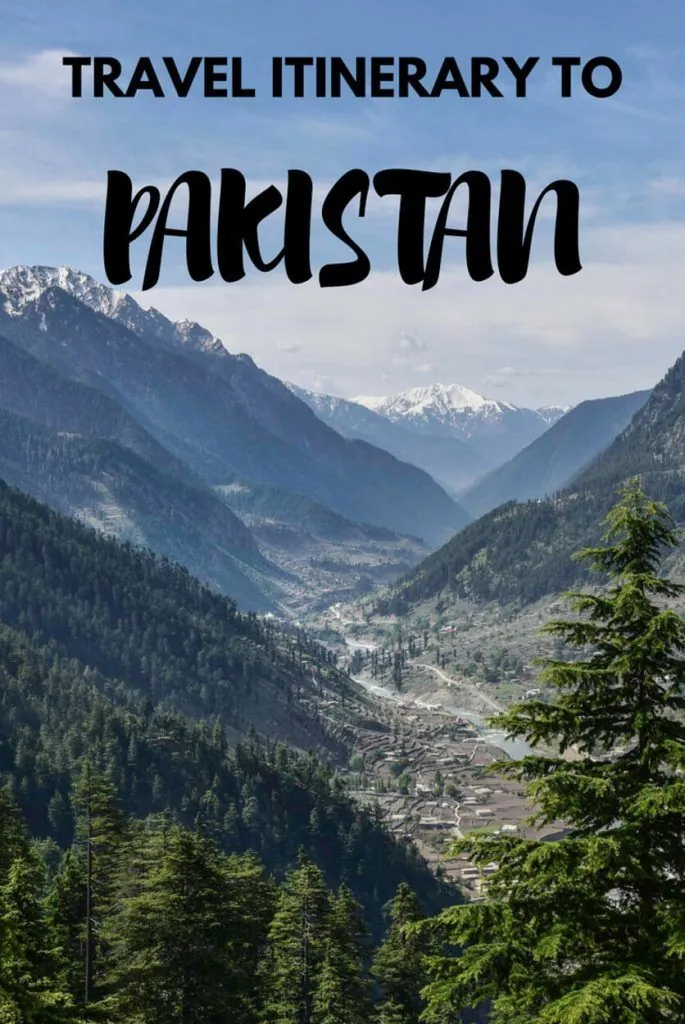
Exploring Pakistan efficiently during your 4-week itinerary ensures you maximize your experience, from majestic mountains to bustling cities.
Exploring by Road
Pakistan boasts a well-developed road network, particularly in the northern regions. The Karakoram Highway, which connects Islamabad to the China border, stands out with breathtaking views. Using shared taxis or hiring a private car offers flexibility and better odds of sticking to your schedule. Motorcycle rental provides an adventurous and immersive way to explore scenic routes in Gilgit-Baltistan.
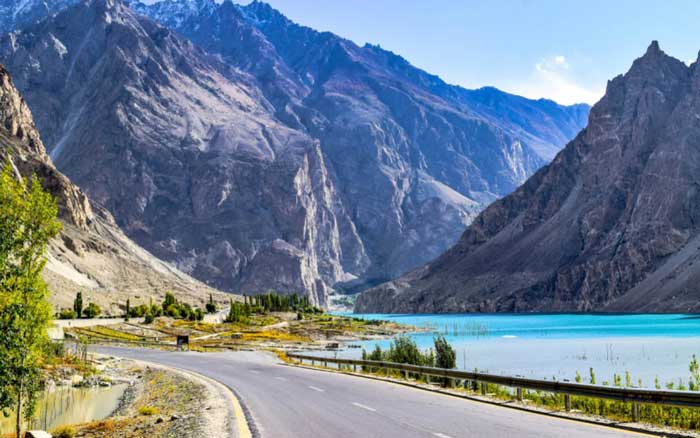
Domestic Flights
Domestic flights can save significant travel time. For instance, flights from Islamabad to Skardu or Gilgit can reduce days of road travel to a few hours. This option is particularly advantageous for covering long distances and ensuring you spend more time exploring rather than traveling.
Public Transit Options
Public buses and trains are available but can be unpredictable in terms of schedules. Buses are more common in urban areas and intercity routes, while trains offer a scenic yet slower alternative. Opt for these if you’re looking for budget-friendly options and have a flexible itinerary.
Optimize your transportation choices to experience the varied landscapes and vibrant culture of Pakistan.
Four Weeks in Pakistan Itinerary
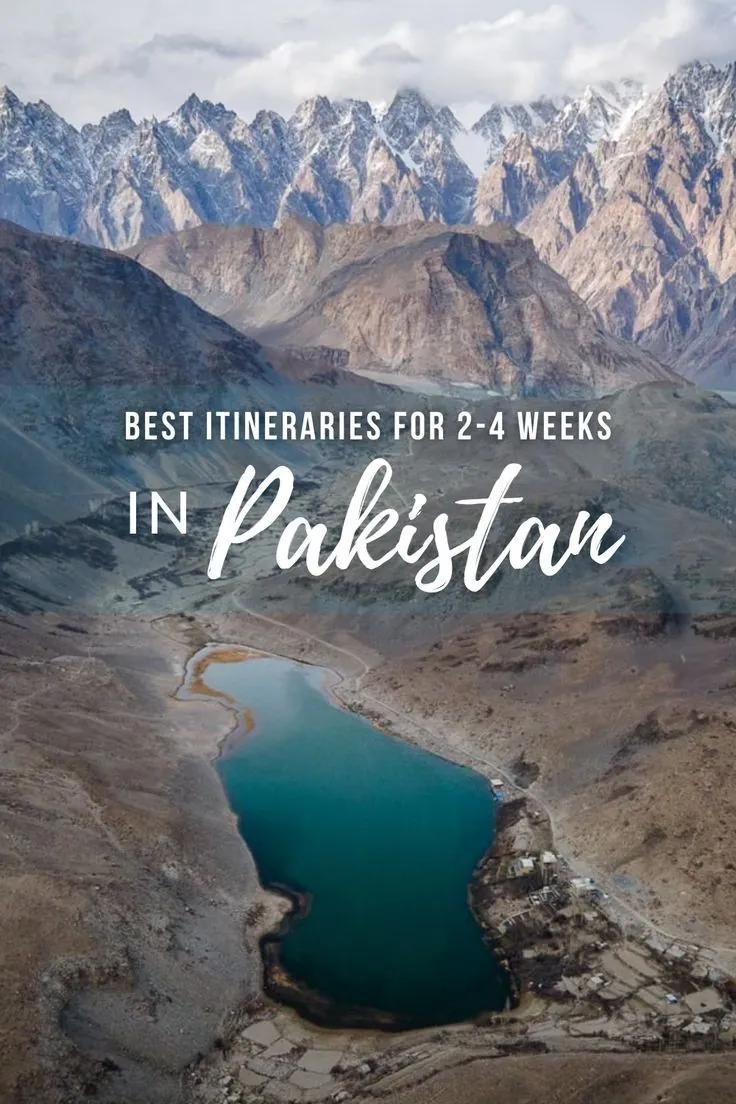
Week 1: Northern Areas
Your 4-week adventure in Pakistan begins in its stunning northern regions, home to dramatic landscapes and rich cultural heritage.
Day 1-2: Islamabad and Rawalpindi
Start your journey in Islamabad, Pakistan’s capital city. Explore its modern architecture and major attractions:
- Faisal Mosque: A marvel of contemporary Islamic architecture.
- Margalla Hills: Offers panoramic city views and hiking trails.
Nearby Rawalpindi provides historical context and traditional experiences:
- Rawalpindi Museum: Jump into Pakistan’s history.
- Old Bazaars: Find unique local goods and souvenirs.
Day 3-4: Naran and Kaghan Valley
Head to Naran and Kaghan Valley, famous for their majestic natural settings. Popular sites include:
- Lake Saif ul Malook: Known for its turquoise waters and mountain backdrop.
- Trekking Paths: Varied trails suited for different skill levels.
This region is ideal for outdoor activities, making it a favorite among nature lovers.
Day 5-6: Hunza Valley
Journey to Hunza Valley, one of the most picturesque spots in Pakistan. Highlights entail:
- Baltit and Altit Forts: Ancient forts with stunning views.
- Karimabad: Immerse yourself in local culture and handicrafts.
Hunza’s serene environment offers both adventure and relaxation opportunities.
Accommodations
| Region | Luxury Hotels | Mid-range Hotels | Budget Options |
|---|---|---|---|
| Islamabad | Serena Hotel | Hotel One | Budget Lodges |
| Naran/Kaghan | Arcadian Sprucewoods | Pine Park Hotel | Guesthouses |
| Hunza Valley | Luxus Hunza | Hunza Embassy Hotel | Hostels |
Dining Highlights
- Islamabad: Savour contemporary and local flavors at restaurants like Monal.
- Naran: Enjoy traditional Pakistani dishes in open-air setups.
- Hunza: Relish regional specialties, such as Hunza Bread and apricot products.
Transportation & Practical Tips
- Getting Around: Use domestic flights for long distances; opt for buses or shared taxis for shorter, scenic routes.
- Local Guides: Enhance your experience with insights from knowledgeable locals.
- Seasonal Notes: Northern areas are best visited in summer for trekking or fall for stunning foliage.
- Eco-friendly Lodging: Choose accommodations employing sustainable practices.
- Waste Management: Carry reusable water bottles and minimize plastic use.
- Respect Nature: Stick to designated paths to preserve fragile ecosystems.
Starting in Pakistan’s northern areas offers a diverse mix of natural beauty and cultural richness, setting a vibrant tone for your extensive exploration.
Week 2: Hunza Valley Exploration
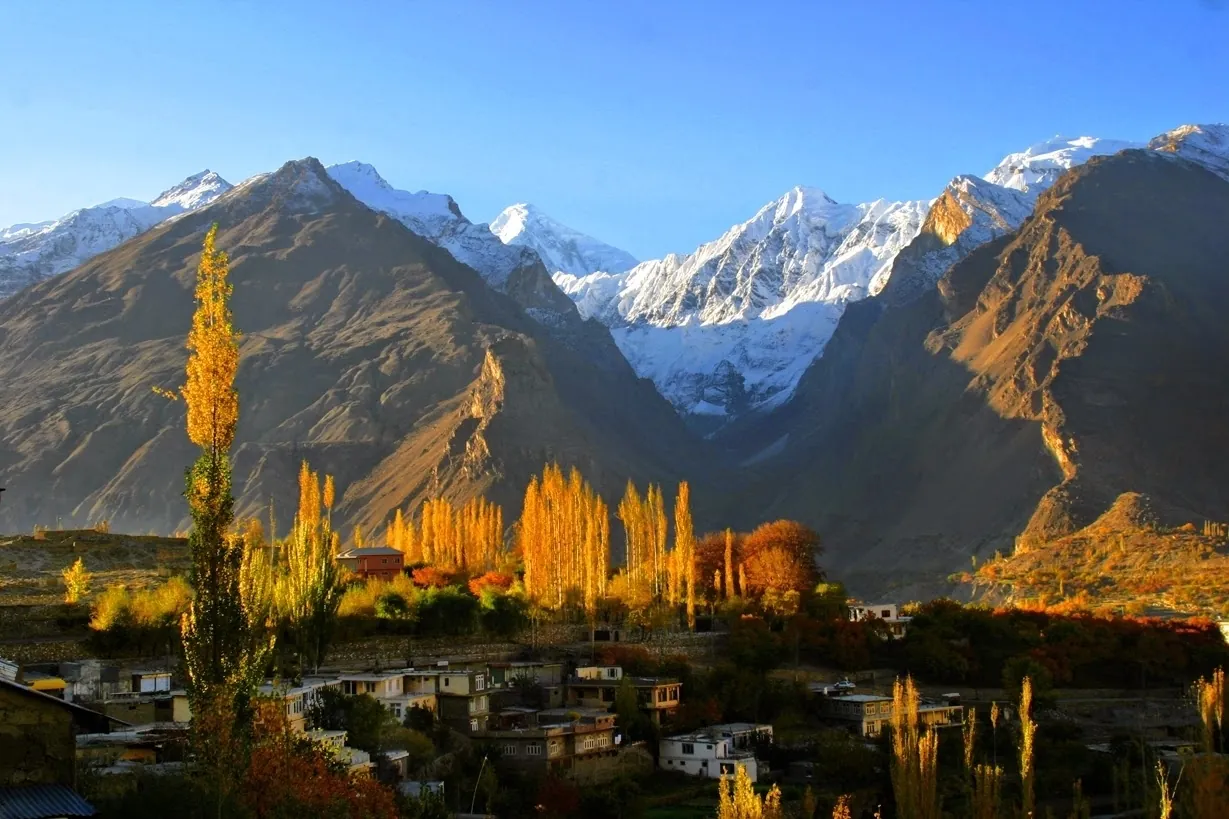
Discover the enchanting Hunza Valley, where stunning natural landscapes meet rich cultural heritage. This week’s itinerary takes you through some of Hunza’s most captivating areas.
Days 8-9: Karimabad
Karimabad, the main town in the Hunza Valley, is renowned for its breathtaking beauty and cultural treasures.
- Baltit Fort: Explore this 700-year-old fort offering panoramic views of the valley and surrounding mountains.
- Eagle’s Nest: Visit this viewpoint to witness awe-inspiring sunsets and a full view of the valley.
- Local Cuisine: Savor traditional Hunza dishes, experiencing the local hospitality.
- Town Stroll: Wander through the town, admiring cherry blossoms in spring or vibrant autumn colors.
Days 10-12: Upper Hunza
Upper Hunza, encompassing areas like Attabad Lake, Ghulkin, and Passu, offers natural wonders.
- Attabad Lake: Marvel at the turquoise waters of this lake created by a 2010 landslide.
- Ghulkin: Explore this serene village known for its stunning world.
- Passu Cones: Admire the jagged peaks of the Passu Cones, a famous natural landmark.
Days 13-14: Phander Valley
Phander Valley, known for its lush green fields and turquoise river, provides an idyllic setting.
- Phander Lake: Enjoy the clear, vibrant waters of Phander Lake.
- Local Markets: Browse through local markets for unique souvenirs.
- Trekking: Participate in trekking opportunities amidst stunning scenic views.
Top Attractions
- Baltit Fort
- Eagle’s Nest
- Attabad Lake
- Passu Cones
Hidden Gems
- Ghulkin Village
- Phander Lake
- Local Markets
Accommodations
| Accommodation | Location | Price Range (per night) | Notable Features |
|---|---|---|---|
| Serena Hunza Inn | Karimabad | $80 – $150 | Panoramic views, luxury amenities |
| Passu Ambassador Hotel | Passu | $50 – $100 | Lake view, local cuisine |
| PTDC Motel Phander | Phander Valley | $40 – $90 | Budget-friendly, scenic surroundings |
Dining Highlights
- Hunza Food Pavillion: Traditional Hunza dishes in Karimabad.
- Hardees Resturant: Local and international cuisine in Upper Hunza.
- Lalazar Hotel Restaurant: Authentic regional dishes in Phander Valley.
Transportation & Practical Tips
- Shared Taxis: Efficient for short-distance travel within Hunza.
- Private Car Hires: Ideal for flexibility in exploring remote areas.
- Motorcycles: For a more immersive journey.
- Eco-Friendly Practices: Carry reusable water bottles, minimize waste, respect local customs.
- Budget Considerations: Opt for budget accommodations and local eateries to manage expenses.
| Month | Temperature (°C) | Rainfall (mm) |
|---|---|---|
| Spring | 10-20 | 50 |
| Summer | 15-30 | 20 |
| Autumn | 5-15 | 30 |
| Winter | -10-5 | 10 |
Week 3: Chitral and Kalash Valleys
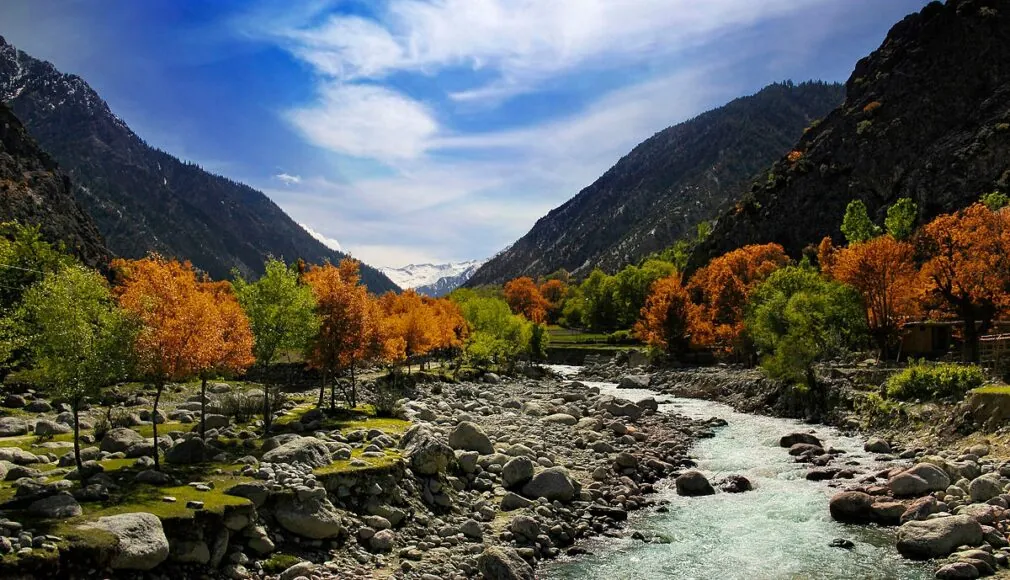
Discover the enchanting landscapes and vibrant cultures of Chitral and the Kalash Valleys in Week 3 of your Pakistan itinerary. This section takes you through breathtaking mountain passes, historic towns, and valleys rich in tradition.
Days 15-16: Shandur Pass
Experience the majesty of the Shandur Pass, situated over 12,000 feet above sea level in the Chitral District of Khyber Pakhtunkhwa. Known for hosting the Shandur Polo Festival each July, this high-altitude pass offers stunning views and a unique cultural experience.
- Top Attractions:
- Polo grounds
- Shandur Lake
- Hidden Gems:
- Surrounding meadows
- Unmarked trails perfect for hiking
Camping is your best accommodation option here due to the lack of hotels. Ensure you’re prepared for cold nights and potential weather changes, especially if you visit outside the summer months.
Days 17-18: Chitral
Chitral, a city in Khyber Pakhtunkhwa, captivates with its natural beauty and cultural significance. After crossing Shandur Pass, Chitral offers a blend of rugged landscapes and deep history.
- Top Attractions:
- Chitral Fort
- Shahi Mosque
- Birmoghlasht (summer palace)
- Hidden Gems:
- Garam Chashma hot springs
- Chitral Gol National Park
Accommodations:
| Accommodation | Type | Price Range | Key Features |
|---|---|---|---|
| Hindu Kush Heights | Boutique Hotel | $$ – $$$ | Scenic views, Local cuisine |
| Tirich Mir View Hotel | Budget Hotel | $ – $$ | Central location, Affordable |
Dining Highlights:
- Chitrali cuisine: Enjoy local dishes at restaurants like Tirich Mir View Hotel’s in-house dining.
- Must-try dishes: Shopan (meat stew), Warmund (bread).
Transportation & Practical Tips:
- Getting around: Shared jeeps and buses are common.
- Seasonal variations: Best visited in spring and summer when the weather is mild.
- Sustainability tips: Support eco-friendly lodgings, minimize plastic use.
Days 19-21: Kalash Valleys
The Kalash Valleys, consisting of Bumburet, Rumbur, and Birir, are renowned for their unique culture and stunning landscapes. Immerse yourself in the vibrant traditions of the Kalash people and explore verdant valleys.
- Top Attractions:
- Kalash Museum
- Uchal Festival (celebrated in August)
- Hidden Gems:
- Remote village tours
- Local craft markets
Accommodations:
| Accommodation | Type | Price Range | Key Features |
|---|---|---|---|
| Kalash Guest House | Guest House | $ – $$ | Traditional decor, Local food |
| PTDC Motel | Motel | $$ – $$$ | Comfortable, Nearby attractions |
Dining Highlights:
- Local eateries: Taste traditional Kalash food.
- Notable dishes: Walnut bread, Mulberries.
Transportation & Practical Tips:
- Getting around: Private hires recommended due to remote locations.
- Budget considerations: Cheaper accommodations and food options available.
- Sustainability tips: Respect local customs, minimize waste.
These days in Chitral and the Kalash Valleys will fully immerse you in Pakistan’s rich cultural world. Each destination showcases the country’s diverse landscapes and traditions, ensuring an unforgettable journey.
Week 4: Cultural Heartland
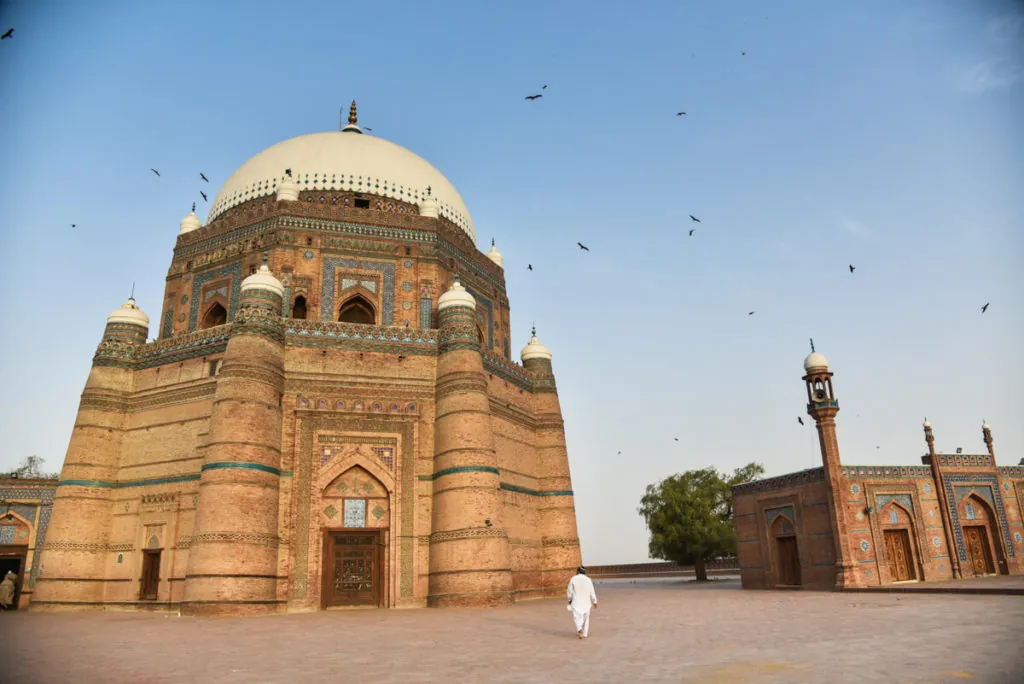
Days 22-23: Peshawar
Exploring Peshawar, one of Asia’s oldest cities, offers an intriguing glance at its rich history and cultural landmarks. Situated near the Afghan border, Peshawar served as the capital of the Kushan Empire and is a key point on the ancient Silk Road.
Top Attractions:
- Peshawar Museum: Houses an extensive collection of Gandhara art.
- Bala Hissar Fort: Offers panoramic views of the city and surrounding mountains.
- Chowk Yadgar and Khyber Super Market: Vibrant bazaars perfect for picking up local handicrafts.
Hidden Gems:
- Qissa Khwani Bazaar: A hub for storytellers and local coffee shops.
- Sethi House Museum: Showcases luxurious heritage with intricate woodwork.
Accommodations:
| Name | Location | Price Range | Features |
|---|---|---|---|
| Pearl Continental | City Center | $$$ | Spa, Fine Dining |
| Shelton’s Rezidor | Near Fort | $$ | Restaurant, Airport Shuttle |
| Fort Continental | Cantonment | $ | Business Center, Free Breakfast |
Dining Highlights:
- Charsi Tikka: Renowned for succulent lamb dishes.
- Café Crunch: Offers a mix of local and international cuisines.
Transportation & Practical Tips:
- Transportation: Opt for local rickshaws or book a private car to explore comfortably.
- Dress Code: Wear a salwar kameez for a culturally immersive experience.
Days 24-26: Lahore
Lahore, the pulsating heart of Pakistan, captivates with Mughal-era architecture and lively bazaars. Expect a blend of history and modern vibrancy.
Top Attractions:
- Lahore Fort (Shahi Qila): A UNESCO World Heritage site.
- Badshahi Mosque: One of the world’s largest mosques.
- Wazir Khan Mosque: Known for its elaborate tile work.
Hidden Gems:
- Shalimar Gardens: Serene escape with Mughal-era landscaping.
- Anarkali Bazaar: Oldest market offering textiles to souvenirs.
Accommodations:
| Name | Location | Price Range | Features |
|---|---|---|---|
| Avari Hotel | Mall Road | $$$ | Pool, Business Center |
| Luxus Grand | Gulberg | $$ | Gym, Restaurant |
| Agoda Hotel | Anarkali | $ | Free Wi-Fi, Close to Attractions |
Dining Highlights:
- Haveli Restaurant: Dine with a view of Badshahi Mosque.
- Phaja Siri Paye: Famous for traditional goat trotters.
Transportation & Practical Tips:
- Transportation: Use Uber and Careem for convenient travel.
- Local Customs: Greeting warmly with “Assalam-o-Alaikum” enhances local interactions.
Days 27-29: Multan or Bahawalpur
Between Multan’s spiritual aura and Bahawalpur’s royal grandeur, this three-day leg presents a deep jump into southern Punjab’s cultural world.
Top Attractions in Multan:
- Shrine of Bahauddin Zakariya: A Sufi heritage site.
- Multan Arts Council: Venue for traditional performances.
Top Attractions in Bahawalpur:
- Noor Mahal: A palatial marvel.
- Derawar Fort: Historic fortification with breathtaking views.
Hidden Gems:
- Blue Pottery of Multan: Unique handmade crafts.
- Bahawalpur Museum: Exhibits the region’s royal past.
Accommodations:
| Name | Location | Price Range | Features |
|---|---|---|---|
| Ramada Multan | City Center | $$$ | Business Center, Pool |
| Hotel One Bahawalpur | Cantonment | $$ | Restaurant, Wi-Fi |
| Hotel Grace | Near Bazaar | $ | Parking, Free Breakfast |
Dining Highlights:
- Multan’s Sohan Halwa: Sweet delicacy not to miss.
- CSD Canteen: Affordable meals with local flair in Bahawalpur.
Transportation & Practical Tips:
- Transportation: Local buses are efficient for inter-city travel.
- Budget Considerations: Street food provides both taste and savings.
Day 30: Return to Islamabad
After soaking in cultural richness, return to Islamabad to complete your journey. Relish in the memories created and perhaps plan your next adventure.
Packing for Pakistan
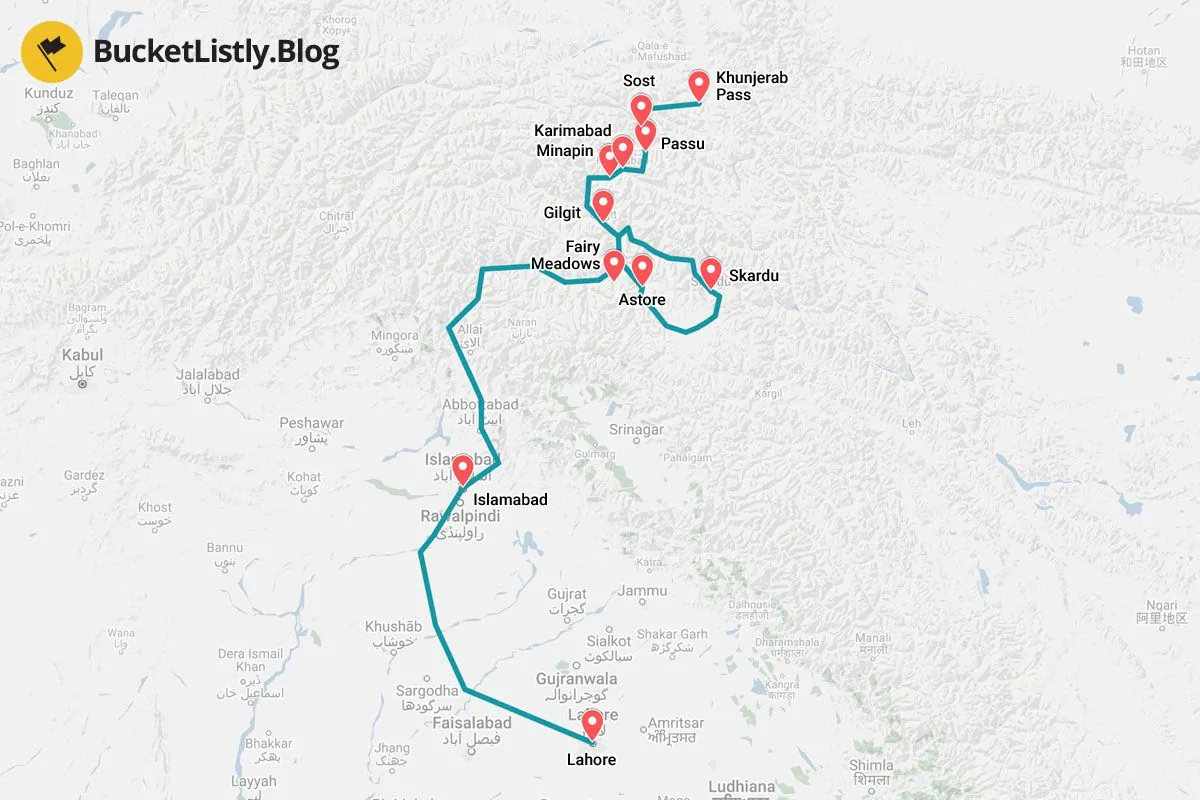
Traveling to Pakistan offers a rich world of experiences from the bustling cities to remote mountain valleys. Given the diverse landscapes and climates, packing thoughtfully ensures a smooth and enjoyable journey.
Essential Items
Certain items are indispensable for your trip. A reliable travel backpack accommodates day trips and longer excursions. Pack a high-quality camera to capture the picturesque landscapes. Bring a universal travel adapter because Pakistan uses standard voltage 230 V and the frequency 50 Hz. A power bank is crucial, especially in remote areas with limited charging facilities. A reusable water bottle reduces plastic waste and keeps you hydrated.
Clothing Tips
Pack clothes suitable for diverse climates. Layering is key. Include t-shirts, long sleeves, and a waterproof jacket because temperatures can range dramatically. Light, breathable fabrics like cotton are perfect for hot, humid days in the southern regions. Warm clothes, including thermal wear, are necessary for northern areas, especially at higher altitudes. Modest clothing respects local customs and provides comfort. Women might consider scarves or shawls, while both men and women benefit from lightweight, long pants. Comfortable walking shoes are a must for extensive sightseeing and trekking.
Safety And Health Supplies
A basic first aid kit, including band-aids, antiseptics, and pain relievers, is essential. Prescription medication should be accompanied by a doctor’s note. Recommended vaccinations include hepatitis A and B, typhoid, and tetanus. Insect repellent protects against mosquitos, particularly in warmer areas. Hand sanitizer and wet wipes maintain hygiene, especially in remote locations. Carry a high SPF sunscreen to protect against intense sun exposure in open areas like the Deosai National Park.
By preparing well, you enhance your ability to fully immerse in the diverse and captivating landscapes of Pakistan.
Conclusion
Embarking on this 4-week journey through Pakistan promises an adventure like no other. From the majestic peaks of the Karakoram Range to the vibrant streets of Lahore, you’ll encounter a wealth of history, culture, and natural beauty. Each region offers unique experiences that cater to every traveler’s interests.
By planning your visit around the best seasons and optimizing your transportation choices, you’ll maximize your time and enjoyment. Whether you’re exploring ancient ruins, trekking through serene valleys, or savoring local delicacies, Pakistan’s diverse landscapes and rich heritage will leave you with unforgettable memories.
So pack thoughtfully, stay informed, and get ready to immerse yourself in the wonders of Pakistan. This itinerary is your gateway to discovering a land of breathtaking beauty and vibrant traditions. Safe travels!
Frequently Asked Questions
How many days should I stay in Pakistan?
To fully experience both North and South Pakistan, at least four weeks are recommended. This itinerary allows for a comprehensive exploration of the country’s diverse landscapes, cultures, and historical sites.
How long can Americans stay in Pakistan?
Americans can stay in Pakistan for up to 30 days on a tourist visa. For extended stays, it is advised to contact the nearest Pakistani embassy or consulate for information on long-stay visa options and extensions.
Is Pakistan a cheap country to visit?
Yes, Pakistan is an affordable destination due to the favorable exchange rate for foreign currencies. Travelers can enjoy much of what the country has to offer without spending a lot, making it a budget-friendly option.
What currency should I take to Pakistan?
US Dollars and Euros are the easiest and most reliable currencies to exchange in Pakistan. It is advisable to exchange money upon arrival at international airports, which have 24-hour exchange bureaus for convenience.
Is Pakistan safe for American tourists?
Though generally safe for tourists, travelers should stay updated on the security situation and exercise caution due to potential risks of terrorism, kidnapping, and civil unrest. Staying informed through local news and consular advisories is recommended.
When is the best time to visit Pakistan?
The best times to visit Pakistan are during spring (March to May) and autumn (September to November). These seasons offer mild weather, making it ideal for exploring both northern and southern regions of the country.
What are the top attractions in Pakistan?
Top attractions include the Karakoram Range, Lahore’s vibrant streets, Hunza Valley, and Mohenjo-Daro ruins. The article’s 4-week itinerary highlights both hidden gems and iconic landmarks across the country.
How should I get around Pakistan during the 4-week itinerary?
Travel options include shared taxis, private hires, motorcycle rentals, domestic flights, buses, and trains. The Karakoram Highway is notable for its scenic views, while domestic flights are recommended for longer distances.
What should I pack for a trip to Pakistan?
Pack a reliable travel backpack, a camera, universal travel adapter, power bank, reusable water bottle, layered clothing for varied climates, breathable fabrics, warm clothes for northern areas, a first aid kit, recommended vaccinations, insect repellent, and sunscreen.
What accommodation options are available in Pakistan?
Accommodation ranges from luxury hotels to cozy lodges and guesthouses. The article provides detailed suggestions for each region, ensuring options that cater to various budgets and preferences.

